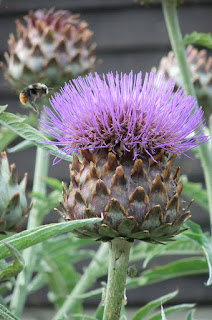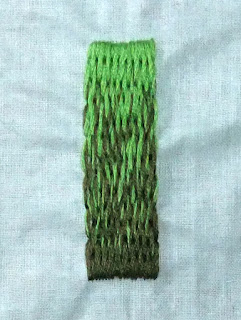Friday, 23 March 2012
Assignment 1: Project Two - Stage Six - using thread and yarns to create textures
For this stage I chose a sketch of a cardoon plant that grows in my in-laws' garden. It is like a huge thistle and reminds me of an old-fashioned shaving brush my grandad used to use.
I decided to focus in on the top of the plant as it has lots of interesting texture with the feathery "bristles" and thick, scale-like outer shell.
I used a range of threads, embroidery floss, wool, crewel wools. I split the embroidery floss and worked with different numbers of strands to create the feathery effects. I interspersed these with crewel wools so that the light-reflective floss stood out, adding additional texture and depth. The thicker wools reflect the tough outer casing and I added plum-coloured floss to show the colour striations in the "scales". For the background I used a dark-coloured hessian fabric to give a rustic feel.
These photographs of the plant show the key features from different angles.
Learning Log
I feel that the stitching has captured the texture in the plant. Although I used simple straight stitches I found that this was appropriate when combined with using different thicknesses and lengths of stitch. I also split the stitches to create additional texture.
The source material worked well, having good colour, shape and texture. An alternative would have been to work with the leaves as these also had good texture.
The sketch is not particularly strong, the pencils did not give particularly rich colour. However, when combined with the compositional photos and given that I was primarily concerned with texture and shape, it gave an acceptable basis to work from.
I enjoyed working with both yarns and stitches to create different textures and I find like both for different reasons depending on the circumstances. Stitch-selection influences the choice of yarn and vice versa. On balance I prefer the use of stitch over yarn as there is greater flexibility and it requires fewer resources!
For example, I have found that a very wide range of textures and stitches can be created with embroidery floss and crewel wool. This is due to the fineness of the thread allowing texture to be built up and many colours can be created by combining fine threads of different colours. Thicker threads can also be made by using several strands at once. This is a good method for subtle shading as in this example using embroidery floss.
Whilst yarns can be a great choice for texture, it is necessary to have a much more wide-ranging stock of source materials. Furthermore, for some textures, thick yarns require heavier fabrics to support the weight as was evident from this sample and my whirlpool galaxy piece.
Project scale also influences the relative importance of stitch vs yarns. For small-scale projects finer threads give greater flexibility. For large-scale projects there is much more scope to explore different yarns and threads and incorporate highly-textured and varied yarns, as well as other handmade "yarns" from fabric strips, plastic etc. These are more difficult to use on a small scale.
In terms of techniques I have barely scratched the surface! I have put together a small travel pack of threads and fabrics so I can practice stitching-on-the-go. I think it will help me to overcome my discomfort with drawing if I can intersperse it with stitch-sketching, starting with the stitch, taking a photo and finishing the stitching later if I don't finish whilst directly observing the source. (I will still be doing more traditional sketching, too!). I've also purchased some seondhand stitch dictionaries for more formal practice. I plan to carry on with my machine-stitch samplers on the Bernina.
A common theme so far is in relation to size. I tend to work on a small scale or lifesize. I'd like to do some larger-scale work as I think it might encourage me to interpret images more freely and less literally.








